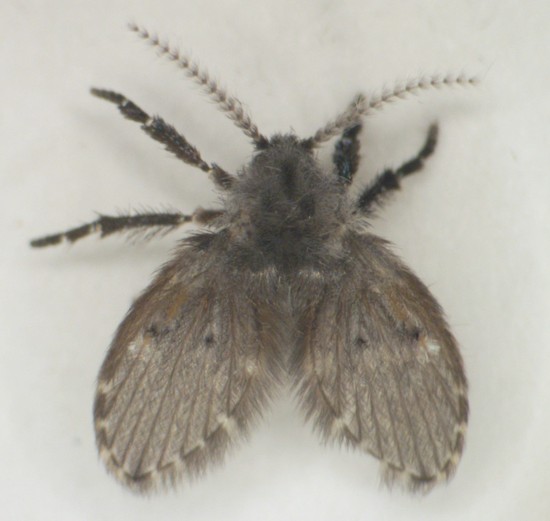Moth Fly
 Scientific Name
Scientific Name
Psychoda sp.
Habitat
Breeds in sewage filter plants and is often called a drain fly. It also breeds in moist areas in the house such as clogged overflow pipes of sinks and tubs, hence the name drain fly.
Life Cycle
Drain flies reproduce in polluted, shallow water or highly moist organic solids. The eggs, larvae and pupae can be found in the slime, or gelatinous film accumulating on the sides of drains and overflow pipes in homes, or in sewage disposal beds, septic tanks and moist compost. Eggs take about 2 days to hatch. Larvae feed on the decaying organic matter, microorganisms, algae and sediment in the media. Larvae mature in 9 to 15 days and are considered valuable organisms along with the organic film in purifying sewage water. Larvae live in the organic film, breathing through tubes and feeding on sediment, decaying vegetation, along with microscopic plants and animals in filters at sewage plants. Pupae occur in or on the surface of the breeding media and, after 20 to 40 hours, new adults emerge. The life cycle can be completed in one to three weeks. Adults live about two weeks, with old ones dying and new ones emerging. They feed on flower nectar and polluted water. During the day, adults rest in shaded areas or on walls near plumbing fixtures and on the sides of showers and tubs. Most activity occurs during the evening when these flies are seen hovering about drains and sinks. They may breed in large numbers at sewage filter plants and then may be carried by prevailing wind to nearby homes up to a mile away. Adults are small enough to pass through ordinary window screening.
Description
Adult moth flies are tiny (1/5 to 1/6 inch long), fuzzy, dark or grayish insects with the body and wings densely covered with hairs. The antennae are 13 segmented, with each segment having a "bulbous swelling" with a whorl of long hairs. Wings are held roof-like over the body when at rest, giving a mothlike appearance. They are weak fliers and make irregular, hesitating flights covering only a few feet in short, jerky lines. Eggs are tiny, brown or cream-colored and are laid in irregular masses of 10 to 200. Larvae are legless, about 3/8 inch long, wormlike and gray, with both ends somewhat darker.
Control
Please contact your local county extension office for current information.
